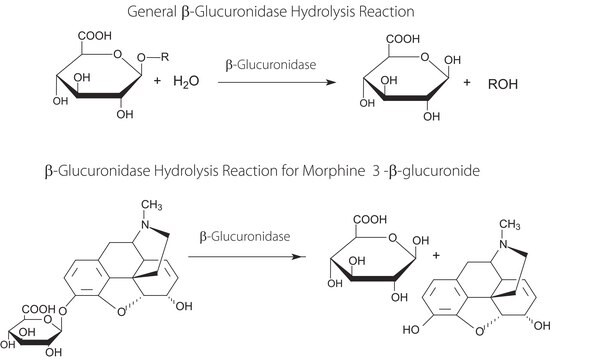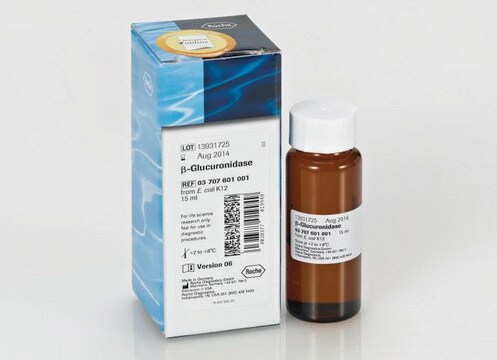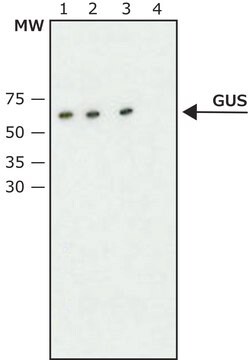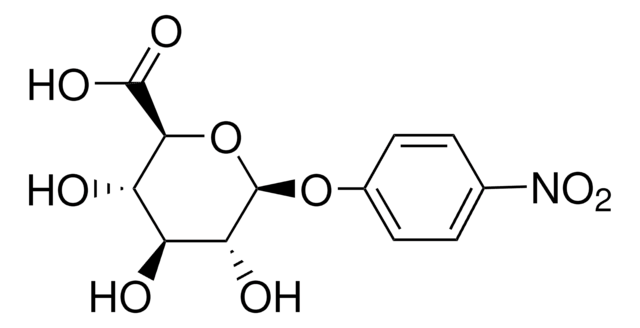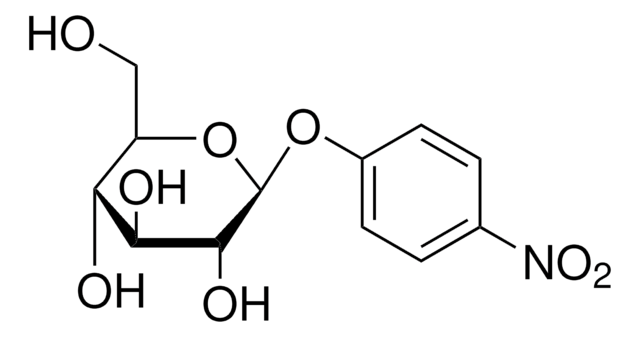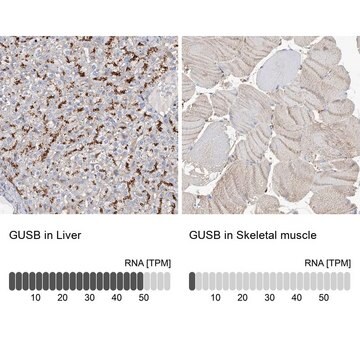G5420
Anti-β-Glucuronidase (N-Terminal) antibody produced in rabbit
~1.5 mg/mL, affinity isolated antibody, buffered aqueous solution
Synonym(s):
Anti-GUS
Sign Into View Organizational & Contract Pricing
All Photos(1)
About This Item
Recommended Products
biological source
rabbit
Quality Level
conjugate
unconjugated
antibody form
affinity isolated antibody
antibody product type
primary antibodies
clone
polyclonal
form
buffered aqueous solution
mol wt
antigen 60 kDa
species reactivity
plant
concentration
~1.5 mg/mL
technique(s)
western blot: 0.5-1 μg/mL using GUS purified from E. coli
shipped in
dry ice
storage temp.
−20°C
target post-translational modification
unmodified
General description
β-Glucuronidase (GUS) is encoded by the E. coli gus gene (also referred to as uidA), GUS protein (60 kDa) is an hydrolase.
Specificity
Anti-β-Glucuronidase (N-Terminal) recognizes bacterial GUS expressed in transgenic tobacco plants.
Immunogen
Sythetic peptide corresponding to amino acids located at the N-terminus of E. coli GUS, conjugated to KLH.
Application
Anti-β-Glucuronidase (N-Terminal) antibody produced in rabbit has been used in western blotting.
Rabbit polyclonal anti-β-Glucuronidase (N-Terminal) antibody may be used for the detection of GUS by immunoblotting (60 kDa). It may be used to detect the reporter GUS marker protein in transgenic plants.
Biochem/physiol Actions
β-Glucuronidase (GUS) is a screenable markers E. coli GUS has been extensively used to monitor transgene delivery to plant tissue.
β-Glucuronidase catalyzes the cleavage of terminal glucuronic acid bound by β-linkage from mono-, oligo-, or polysaccharides or phenols. GUS is mainly used as a marker during transgenic events. In vitro GUS activity assays predominantly facilitates histochemical and fluorometric localization in tissues. GUS activity is also used for the analysis of expression of foreign genes. GUS reporter genes fused with specific promoter genes have been used for the determination of transformed tissues on culture media containing antibiotics. GUS-specific antibodies are helpful in detecting GUS gene product in transformed plants.
Physical form
Solution in 0.01 M phosphate buffered saline, pH 7.4, containing 15 mM sodium azide.
Storage and Stability
For continuous use, store at 2-8 °C for up to one month. For extended storage, freeze in working aliquots. Repeated freezing and thawing, or storage in “frostfree” freezers, is not recommended. If slight turbidity occurs upon prolonged storage, clarify the solution by centrifugation before use. Working dilutions should be discarded if not used within 12 hours.
Disclaimer
Unless otherwise stated in our catalog or other company documentation accompanying the product(s), our products are intended for research use only and are not to be used for any other purpose, which includes but is not limited to, unauthorized commercial uses, in vitro diagnostic uses, ex vivo or in vivo therapeutic uses or any type of consumption or application to humans or animals.
Not finding the right product?
Try our Product Selector Tool.
Related product
Storage Class
10 - Combustible liquids
wgk_germany
WGK 3
flash_point_f
Not applicable
flash_point_c
Not applicable
Choose from one of the most recent versions:
Already Own This Product?
Find documentation for the products that you have recently purchased in the Document Library.
Bacterial glucuronidase as general marker for oncolytic virotherapy or other biological therapies
Hess M, et al.
Journal of Translational Medicine, 9(1), 172-172 (2011)
Michael Hess et al.
Journal of translational medicine, 9, 172-172 (2011-10-13)
Oncolytic viral tumor therapy is an emerging field in the fight against cancer with rising numbers of clinical trials and the first clinically approved product (Adenovirus for the treatment of Head and Neck Cancer in China) in this field. Yet
Release of the recombinant proteins, human serum albumin, ?-glucuronidase, glycoprotein B from human cytomegalovirus, and green fluorescent protein, in root exudates from transgenic tobacco and their effects on microbes and enzymatic activities in soil
Sabharwal N, et al.
Plant Physiology and Biochemistry, 45(6-7), 464-469 (2007)
Vascular-specific expression of GUS and GFP reporter genes in transgenic grapevine (Vitis vinifera L. cv. Albarin
Gago J, et al.
Plant Physiology and Biochemistry, 49(4), 413-419 (2011)
Impact of ubiquitous inhibitors on the GUS gene reporter system: evidence from the model plants Arabidopsis, tobacco and rice and correction methods for quantitative assays of transgenic and endogenous GUS
Fior S, et al.
Plant methods, 5(1), 19-19 (2009)
Our team of scientists has experience in all areas of research including Life Science, Material Science, Chemical Synthesis, Chromatography, Analytical and many others.
Contact Technical Service